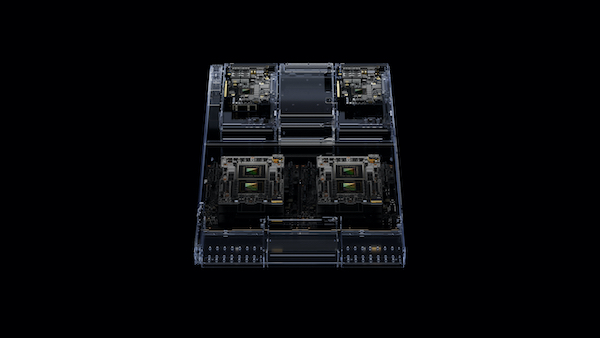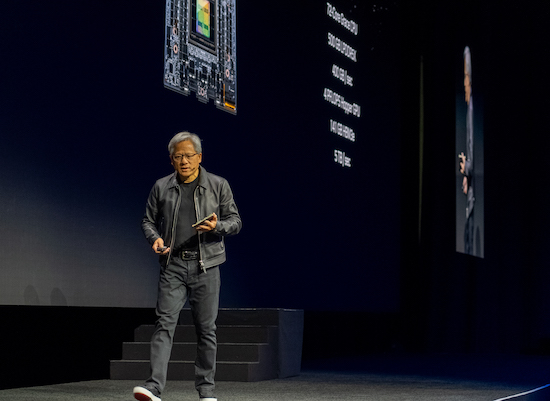
The new GH 200 Grace Hopper GPU, introduced at SIGGRAPH 2023. NVIDIA describes it as a “Superchip Platform for Era of Accelerated Computing and Generative AI.” Image courtesy of NVIDIA.
Latest News
August 18, 2023
NVIDIA CEO Jensen Huang has already made USD the lingua franca of NVIDIA Omniverse™, the company’s development platform for connecting and building 3D pipelines, tools, applications, and services based on OpenUSD. Now he is taking steps to make it the standard for anything 3D via the OpenUSD framework. In his keynote at SIGGRAPH 2023 (Los Angeles, California, August 6-10), he said, “OpenUSD is a big deal, a game changer. It’s going to bring the world onto one standard 3D interchange. It has the opportunity to do for the world, and for computing, what HTML did for the 2D Web.”
In a press release, NVIDIA says, “NVIDIA is advancing the development of OpenUSD—a 3D framework enabling interoperability between software tools and data types for the building of virtual worlds—through NVIDIA Omniverse and a new portfolio of technologies and cloud application programming interfaces (APIs)—including ChatUSD and RunUSD—along with a new NVIDIA OpenUSD Developer Program.”
At the same time, NVIDIA is also championing the Alliance for OpenUSD (AOUSD), an industry initiative to “foster the standardization, development, evolution, and growth of Pixar’s Universal Scene Description technology,” according to the alliance’s newly launched home page. In addition to NVIDIA, Pixar, Adobe, Apple, and Autodesk have joined the alliance as founding members.
All these developments bolster Omniverse, adding new developer capabilities in Omniverse Kit.

We Bet the Company on AI
Huang talked about the launch of RTX series GPUs in 2018 as a watershed moment for him and the company. “You didn't know it at the time, but we did. It was a bet-the-company moment … it's safe to say that it was worth the bet,” he said.
Huang foresaw that rasterization was at its limit, and the GPU’s future was in real-time raytracing. “It required that we reinvent the GPU, added ray tracing accelerators, reinvented the software for rendering, reinvented all the algorithms that we made for rasterization and programmable shading. And that wasn't enough. We had to bring together computer graphics and artificial intelligence (AI) for the very first time to make it possible,” he recounted. This strategy also catapulted NVIDIA into a new territory, transforming it from a graphics acceleration hardware provider to an AI company.
At SIGGRAPH this year, Huang introduced the next-generation GH200 Grace Hopper GPU. He called it the superchip “for the Era of Accelerated Computing and Generative AI.” Holding up the hardware, he said, “It basically turns two superchips into a super-sized superchip, one giant GPU and one giant CPU. The CPU now has 144 cores, the GPU has 10 TB per second of frame buffer bandwidth,” he said.
The dual configuration “delivers up to 3.5x more memory capacity and 3x more bandwidth than the current generation offering,” NVIDIA says in the press announcement. Furthermore, it “comprises a single server with 144 Arm Neoverse cores, eight petaflops of AI performance and 282GB of the latest HBM3e memory technology.”
GH200: GPU for Generative AI
Grace Hopper is targeting generative AI workloads, exemplified by the chatbot ChatGPT, the prompt-based image generator Midjourney, and other similar AI-driven applications.
“The generative AI era is upon us—the iPhone moment of AI, if you will, where all of the technologies of artificial intelligence came together in such a way that it is now possible for us to enjoy AI,” said Huang.
Simulation software developer Ansys has launched AnsysGPT, a virtual assistant incorporating ChatGPT-style natural language processing into their offerings. This is new territory for FEA and CFD vendors, but the software vendors developing AI-enabled solutions see significant opportunities for the technology to enable greater levels of simulation accuracy while also making it easier for users to set up and run advanced analyses.
One place where developers can get access to large language models (LLMs) for training purposes is Hugging Face, an online AI community. The company says its mission is “to democratize good machine learning.” At SIGGRAPH, NVIDIA announced a partnership with Hugging Face, which gives developers access to NVIDIA DGX Cloud AI supercomputing within the Hugging Face platform.
“As part of the collaboration, Hugging Face will offer a new service—called Training Cluster as a Service—to simplify the creation of new and custom generative AI models for the enterprise. Powered by NVIDIA DGX Cloud, the service will be available in the coming months,” NVIDIA says.
NVIDIA AI Workbench - Generative AI for Everyone!
To encourage development of AI applications, NVIDIA announced NVIDIA AI Workbench, a toolkit to quickly use, create, test, and customize pretrained generative AI models and LLMs on PCs, workstations, and remote resources. It brings unprecedented streamlining and automation to local machines, giving data scientists and developers a simple and scalable user experience wherever they choose to work.
The open architecture solves outstanding issues of portability and reproducibility between machines and platforms, and the friendly user interface delivers this solution to a broad range of skills for enterprise users and individual consumers. AI Workbench isn’t just for experts. It is for everybody. Huang said, “If you want to migrate your project so that all of your colleagues can use it and fine-tune other models, you could just tell it where you want to migrate it to. And one click will migrate the project, with all the runtimes, all the libraries, all the complexities, and it runs on workstations and runs in the data center. It runs in the cloud—one single body of code.”
Importantly, AI Workbench solves the last mile problem for individuals and teams that want to get started and scale on the new line of AI Workstations announced at the show. which feature NVIDIA RTX 6000 Ada Generation GPUs, NVIDIA Omniverse, and NVIDIA AI Enterprise Software. Also available are workstations configured with NVIDIA RTX 5000, 4500, and 4000 Ada Generation GPUs, all available from Dell Technologies and other OEM partners soon.
“Few workloads are as challenging as generative AI and digitalization applications, which require a full-stack approach to computing,” said Bob Pette, VP of Professional Visualization at NVIDIA. “Professionals can now tackle these on a desktop with the latest NVIDIA-powered RTX workstations, enabling them to build vast, digitalized worlds in the new age of generative AI.”
More Dell Coverage

More NVIDIA Coverage
Subscribe to our FREE magazine, FREE email newsletters or both!
Latest News








